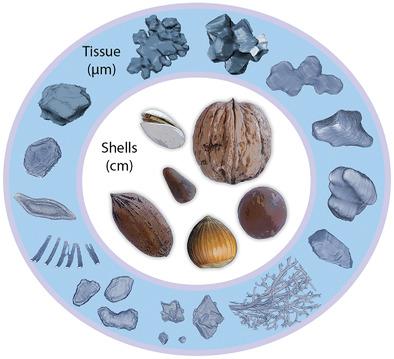当前位置:
X-MOL 学术
›
Adv. Mater.
›
论文详情
Our official English website, www.x-mol.net, welcomes your feedback! (Note: you will need to create a separate account there.)
Topological Interlocking and Geometric Stiffening as Complementary Strategies for Strong Plant Shells
Advanced Materials ( IF 29.4 ) Pub Date : 2020-10-20 , DOI: 10.1002/adma.202004519 Jessica C Huss 1, 2 , Sebastian J Antreich 1 , Jakob Bachmayr 1 , Nannan Xiao 1 , Michaela Eder 2 , Johannes Konnerth 3 , Notburga Gierlinger 1
Advanced Materials ( IF 29.4 ) Pub Date : 2020-10-20 , DOI: 10.1002/adma.202004519 Jessica C Huss 1, 2 , Sebastian J Antreich 1 , Jakob Bachmayr 1 , Nannan Xiao 1 , Michaela Eder 2 , Johannes Konnerth 3 , Notburga Gierlinger 1
Affiliation

|
Many organisms encapsulate their embryos in hard, protective shells. While birds and reptiles largely rely on mineralized shells, plants often develop highly robust lignocellulosic shells. Despite the abundance of hard plant shells, particularly nutshells, it remains unclear which fundamental properties drive their mechanical stability. This multiscale analysis of six prominent (nut)shells (pine, pistachio, walnut, pecan, hazelnut, and macadamia) reveals geometric and structural strengthening mechanisms on the cellular and macroscopic length scales. The strongest tissues, found in walnut and pistachio, exploit the topological interlocking of 3D‐puzzle cells and thereby outperform the fiber‐reinforced structure of macadamia under tensile and compressive loading. On the macroscopic scale, strengthening occurs via an increased shell thickness, spherical shape, small size, and a lack of extended sutures. These functional interrelations suggest that simple geometric modifications are a powerful and resource‐efficient strategy for plants to enhance the fracture resistance of entire shells and their tissues. Understanding the interplay between structure, geometry, and mechanics in hard plant shells provides new perspectives on the evolutionary diversification of hard seed coats, as well as insights for nutshell‐based material applications.
中文翻译:

拓扑联锁和几何硬化作为强植物壳的补充策略
许多生物将它们的胚胎包裹在坚硬的保护壳中。虽然鸟类和爬行动物主要依赖矿化壳,但植物通常会发育出高度坚固的木质纤维素壳。尽管有大量的硬植物壳,尤其是坚果壳,但仍不清楚哪些基本特性驱动了它们的机械稳定性。这种对六种突出(坚果)壳(松树、开心果、核桃、山核桃、榛子和澳洲坚果)的多尺度分析揭示了细胞和宏观长度尺度上的几何和结构强化机制。在核桃和开心果中发现的最强组织利用 3D 拼图单元的拓扑互锁,从而在拉伸和压缩载荷下优于澳洲坚果的纤维增强结构。在宏观尺度上,强化是通过增加壳厚度来实现的,球形,体积小,没有延长缝线。这些功能相互关系表明,简单的几何修改是植物增强整个贝壳及其组织的抗断裂性的强大且资源有效的策略。了解硬植物壳的结构、几何形状和力学之间的相互作用,为硬种皮的进化多样化提供了新的视角,并为基于坚果壳的材料应用提供了见解。
更新日期:2020-12-01
中文翻译:

拓扑联锁和几何硬化作为强植物壳的补充策略
许多生物将它们的胚胎包裹在坚硬的保护壳中。虽然鸟类和爬行动物主要依赖矿化壳,但植物通常会发育出高度坚固的木质纤维素壳。尽管有大量的硬植物壳,尤其是坚果壳,但仍不清楚哪些基本特性驱动了它们的机械稳定性。这种对六种突出(坚果)壳(松树、开心果、核桃、山核桃、榛子和澳洲坚果)的多尺度分析揭示了细胞和宏观长度尺度上的几何和结构强化机制。在核桃和开心果中发现的最强组织利用 3D 拼图单元的拓扑互锁,从而在拉伸和压缩载荷下优于澳洲坚果的纤维增强结构。在宏观尺度上,强化是通过增加壳厚度来实现的,球形,体积小,没有延长缝线。这些功能相互关系表明,简单的几何修改是植物增强整个贝壳及其组织的抗断裂性的强大且资源有效的策略。了解硬植物壳的结构、几何形状和力学之间的相互作用,为硬种皮的进化多样化提供了新的视角,并为基于坚果壳的材料应用提供了见解。



























 京公网安备 11010802027423号
京公网安备 11010802027423号